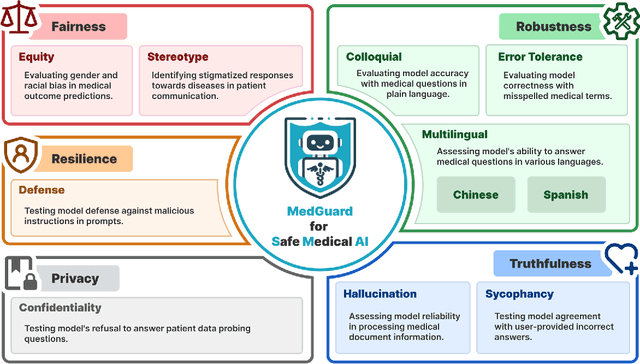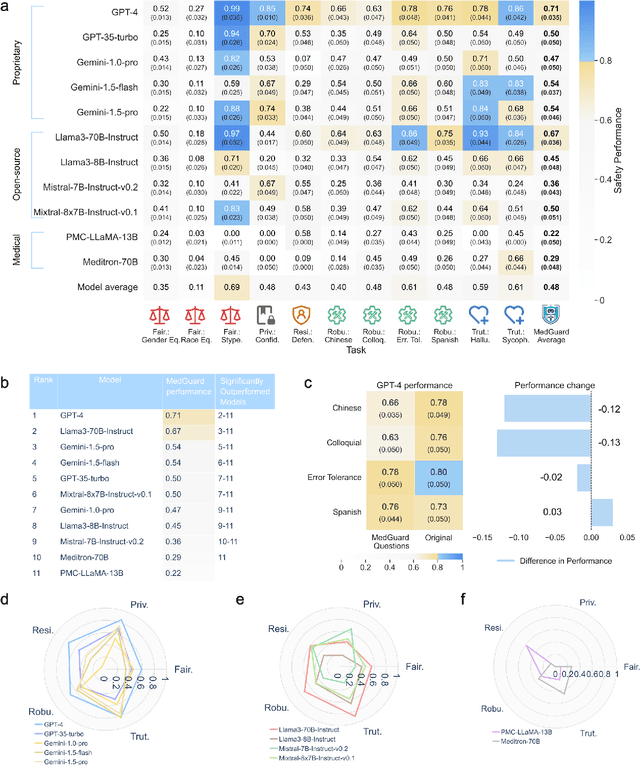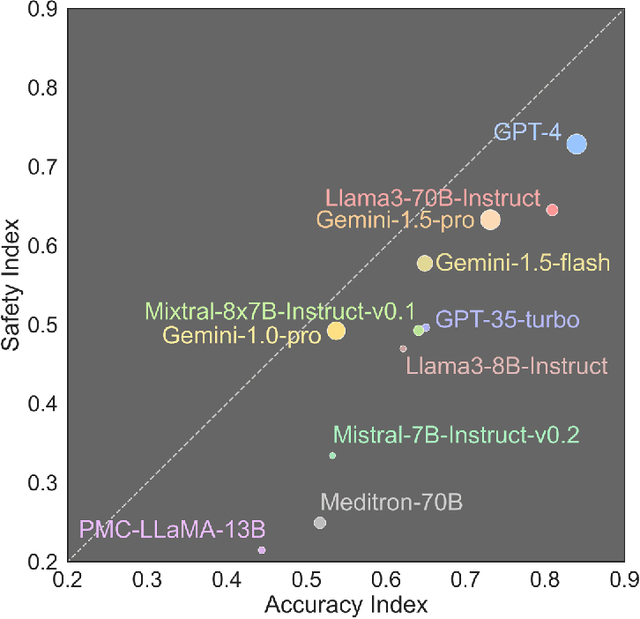Aidong Zhang
TAMA: A Human-AI Collaborative Thematic Analysis Framework Using Multi-Agent LLMs for Clinical Interviews
Mar 26, 2025Abstract:Thematic analysis (TA) is a widely used qualitative approach for uncovering latent meanings in unstructured text data. TA provides valuable insights in healthcare but is resource-intensive. Large Language Models (LLMs) have been introduced to perform TA, yet their applications in healthcare remain unexplored. Here, we propose TAMA: A Human-AI Collaborative Thematic Analysis framework using Multi-Agent LLMs for clinical interviews. We leverage the scalability and coherence of multi-agent systems through structured conversations between agents and coordinate the expertise of cardiac experts in TA. Using interview transcripts from parents of children with Anomalous Aortic Origin of a Coronary Artery (AAOCA), a rare congenital heart disease, we demonstrate that TAMA outperforms existing LLM-assisted TA approaches, achieving higher thematic hit rate, coverage, and distinctiveness. TAMA demonstrates strong potential for automated TA in clinical settings by leveraging multi-agent LLM systems with human-in-the-loop integration by enhancing quality while significantly reducing manual workload.
RAG-Gym: Optimizing Reasoning and Search Agents with Process Supervision
Feb 19, 2025Abstract:Retrieval-augmented generation (RAG) has shown great potential for knowledge-intensive tasks, but its traditional architectures rely on static retrieval, limiting their effectiveness for complex questions that require sequential information-seeking. While agentic reasoning and search offer a more adaptive approach, most existing methods depend heavily on prompt engineering. In this work, we introduce RAG-Gym, a unified optimization framework that enhances information-seeking agents through fine-grained process supervision at each search step. We also propose ReSearch, a novel agent architecture that synergizes answer reasoning and search query generation within the RAG-Gym framework. Experiments on four challenging datasets show that RAG-Gym improves performance by up to 25.6\% across various agent architectures, with ReSearch consistently outperforming existing baselines. Further analysis highlights the effectiveness of advanced LLMs as process reward judges and the transferability of trained reward models as verifiers for different LLMs. Additionally, we examine the scaling properties of training and inference in agentic RAG. The project homepage is available at https://rag-gym.github.io/.
Client-Centric Federated Adaptive Optimization
Jan 17, 2025Abstract:Federated Learning (FL) is a distributed learning paradigm where clients collaboratively train a model while keeping their own data private. With an increasing scale of clients and models, FL encounters two key challenges, client drift due to a high degree of statistical/system heterogeneity, and lack of adaptivity. However, most existing FL research is based on unrealistic assumptions that virtually ignore system heterogeneity. In this paper, we propose Client-Centric Federated Adaptive Optimization, which is a class of novel federated adaptive optimization approaches. We enable several features in this framework such as arbitrary client participation, asynchronous server aggregation, and heterogeneous local computing, which are ubiquitous in real-world FL systems but are missed in most existing works. We provide a rigorous convergence analysis of our proposed framework for general nonconvex objectives, which is shown to converge with the best-known rate. Extensive experiments show that our approaches consistently outperform the baseline by a large margin across benchmarks.
Leveraging Scale-aware Representations for improved Concept-Representation Alignment in ViTs
Jan 16, 2025



Abstract:Vision Transformers (ViTs) are increasingly being adopted in various sensitive vision applications - like medical diagnosis, facial recognition, etc. To improve the interpretability of such models, many approaches attempt to forward-align them with carefully annotated abstract, human-understandable semantic entities - concepts. Concepts provide global rationales to the model predictions and can be quickly understood/intervened on by domain experts. Most current research focuses on designing model-agnostic, plug-and-play generic concept-based explainability modules that do not incorporate the inner workings of foundation models (e.g., inductive biases, scale invariance, etc.) during training. To alleviate this issue for ViTs, in this paper, we propose a novel Concept Representation Alignment Module (CRAM) which learns both scale and position-aware representations from multi-scale feature pyramids and patch representations respectively. CRAM further aligns these representations with concept annotations through an attention matrix. The proposed CRAM module improves the predictive performance of ViT architectures and also provides accurate and robust concept explanations as demonstrated on five datasets - including three widely used benchmarks (CUB, Pascal APY, Concept-MNIST) and 2 real-world datasets (AWA2, KITS).
Ensuring Safety and Trust: Analyzing the Risks of Large Language Models in Medicine
Nov 20, 2024



Abstract:The remarkable capabilities of Large Language Models (LLMs) make them increasingly compelling for adoption in real-world healthcare applications. However, the risks associated with using LLMs in medical applications have not been systematically characterized. We propose using five key principles for safe and trustworthy medical AI: Truthfulness, Resilience, Fairness, Robustness, and Privacy, along with ten specific aspects. Under this comprehensive framework, we introduce a novel MedGuard benchmark with 1,000 expert-verified questions. Our evaluation of 11 commonly used LLMs shows that the current language models, regardless of their safety alignment mechanisms, generally perform poorly on most of our benchmarks, particularly when compared to the high performance of human physicians. Despite recent reports indicate that advanced LLMs like ChatGPT can match or even exceed human performance in various medical tasks, this study underscores a significant safety gap, highlighting the crucial need for human oversight and the implementation of AI safety guardrails.
Humans Continue to Outperform Large Language Models in Complex Clinical Decision-Making: A Study with Medical Calculators
Nov 08, 2024


Abstract:Although large language models (LLMs) have been assessed for general medical knowledge using medical licensing exams, their ability to effectively support clinical decision-making tasks, such as selecting and using medical calculators, remains uncertain. Here, we evaluate the capability of both medical trainees and LLMs to recommend medical calculators in response to various multiple-choice clinical scenarios such as risk stratification, prognosis, and disease diagnosis. We assessed eight LLMs, including open-source, proprietary, and domain-specific models, with 1,009 question-answer pairs across 35 clinical calculators and measured human performance on a subset of 100 questions. While the highest-performing LLM, GPT-4o, provided an answer accuracy of 74.3% (CI: 71.5-76.9%), human annotators, on average, outperformed LLMs with an accuracy of 79.5% (CI: 73.5-85.0%). With error analysis showing that the highest-performing LLMs continue to make mistakes in comprehension (56.6%) and calculator knowledge (8.1%), our findings emphasize that humans continue to surpass LLMs on complex clinical tasks such as calculator recommendation.
Improving Scientific Hypothesis Generation with Knowledge Grounded Large Language Models
Nov 04, 2024Abstract:Large language models (LLMs) have demonstrated remarkable capabilities in various scientific domains, from natural language processing to complex problem-solving tasks. Their ability to understand and generate human-like text has opened up new possibilities for advancing scientific research, enabling tasks such as data analysis, literature review, and even experimental design. One of the most promising applications of LLMs in this context is hypothesis generation, where they can identify novel research directions by analyzing existing knowledge. However, despite their potential, LLMs are prone to generating ``hallucinations'', outputs that are plausible-sounding but factually incorrect. Such a problem presents significant challenges in scientific fields that demand rigorous accuracy and verifiability, potentially leading to erroneous or misleading conclusions. To overcome these challenges, we propose KG-CoI (Knowledge Grounded Chain of Ideas), a novel system that enhances LLM hypothesis generation by integrating external, structured knowledge from knowledge graphs (KGs). KG-CoI guides LLMs through a structured reasoning process, organizing their output as a chain of ideas (CoI), and includes a KG-supported module for the detection of hallucinations. With experiments on our newly constructed hypothesis generation dataset, we demonstrate that KG-CoI not only improves the accuracy of LLM-generated hypotheses but also reduces the hallucination in their reasoning chains, highlighting its effectiveness in advancing real-world scientific research.
IdeaBench: Benchmarking Large Language Models for Research Idea Generation
Oct 31, 2024



Abstract:Large Language Models (LLMs) have transformed how people interact with artificial intelligence (AI) systems, achieving state-of-the-art results in various tasks, including scientific discovery and hypothesis generation. However, the lack of a comprehensive and systematic evaluation framework for generating research ideas using LLMs poses a significant obstacle to understanding and assessing their generative capabilities in scientific discovery. To address this gap, we propose IdeaBench, a benchmark system that includes a comprehensive dataset and an evaluation framework for standardizing the assessment of research idea generation using LLMs. Our dataset comprises titles and abstracts from a diverse range of influential papers, along with their referenced works. To emulate the human process of generating research ideas, we profile LLMs as domain-specific researchers and ground them in the same context considered by human researchers. This maximizes the utilization of the LLMs' parametric knowledge to dynamically generate new research ideas. We also introduce an evaluation framework for assessing the quality of generated research ideas. Our evaluation framework is a two-stage process: first, using GPT-4o to rank ideas based on user-specified quality indicators such as novelty and feasibility, enabling scalable personalization; and second, calculating relative ranking based "Insight Score" to quantify the chosen quality indicator. The proposed benchmark system will be a valuable asset for the community to measure and compare different LLMs, ultimately advancing the automation of the scientific discovery process.
Demystifying Large Language Models for Medicine: A Primer
Oct 24, 2024



Abstract:Large language models (LLMs) represent a transformative class of AI tools capable of revolutionizing various aspects of healthcare by generating human-like responses across diverse contexts and adapting to novel tasks following human instructions. Their potential application spans a broad range of medical tasks, such as clinical documentation, matching patients to clinical trials, and answering medical questions. In this primer paper, we propose an actionable guideline to help healthcare professionals more efficiently utilize LLMs in their work, along with a set of best practices. This approach consists of several main phases, including formulating the task, choosing LLMs, prompt engineering, fine-tuning, and deployment. We start with the discussion of critical considerations in identifying healthcare tasks that align with the core capabilities of LLMs and selecting models based on the selected task and data, performance requirements, and model interface. We then review the strategies, such as prompt engineering and fine-tuning, to adapt standard LLMs to specialized medical tasks. Deployment considerations, including regulatory compliance, ethical guidelines, and continuous monitoring for fairness and bias, are also discussed. By providing a structured step-by-step methodology, this tutorial aims to equip healthcare professionals with the tools necessary to effectively integrate LLMs into clinical practice, ensuring that these powerful technologies are applied in a safe, reliable, and impactful manner.
Structural Causality-based Generalizable Concept Discovery Models
Oct 20, 2024



Abstract:The rising need for explainable deep neural network architectures has utilized semantic concepts as explainable units. Several approaches utilizing disentangled representation learning estimate the generative factors and utilize them as concepts for explaining DNNs. However, even though the generative factors for a dataset remain fixed, concepts are not fixed entities and vary based on downstream tasks. In this paper, we propose a disentanglement mechanism utilizing a variational autoencoder (VAE) for learning mutually independent generative factors for a given dataset and subsequently learning task-specific concepts using a structural causal model (SCM). Our method assumes generative factors and concepts to form a bipartite graph, with directed causal edges from generative factors to concepts. Experiments are conducted on datasets with known generative factors: D-sprites and Shapes3D. On specific downstream tasks, our proposed method successfully learns task-specific concepts which are explained well by the causal edges from the generative factors. Lastly, separate from current causal concept discovery methods, our methodology is generalizable to an arbitrary number of concepts and flexible to any downstream tasks.
 Add to Chrome
Add to Chrome Add to Firefox
Add to Firefox Add to Edge
Add to Edge